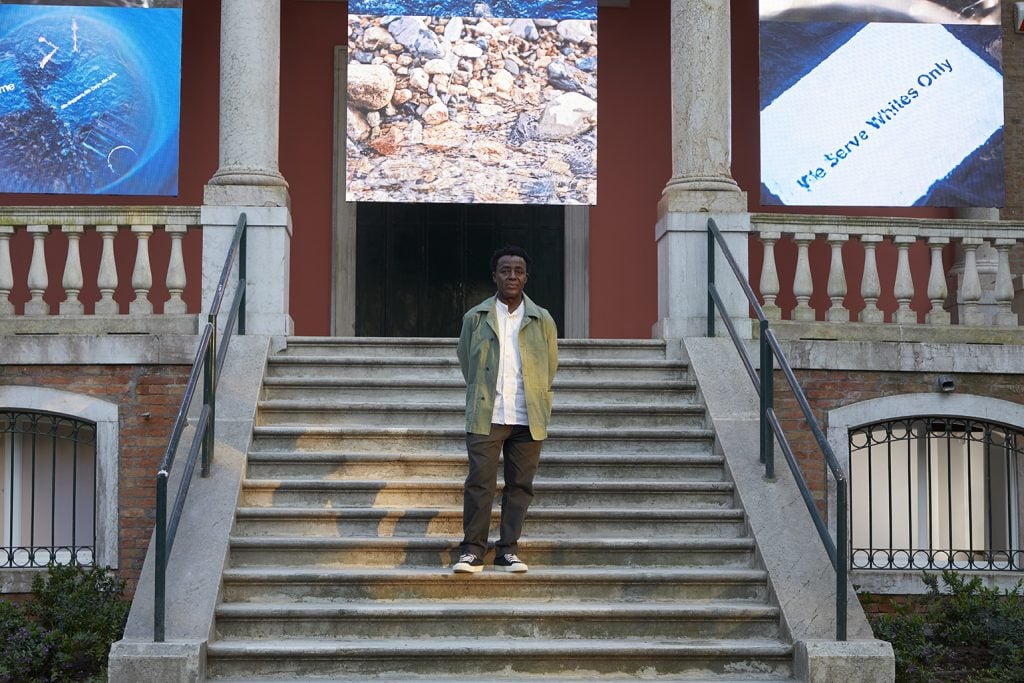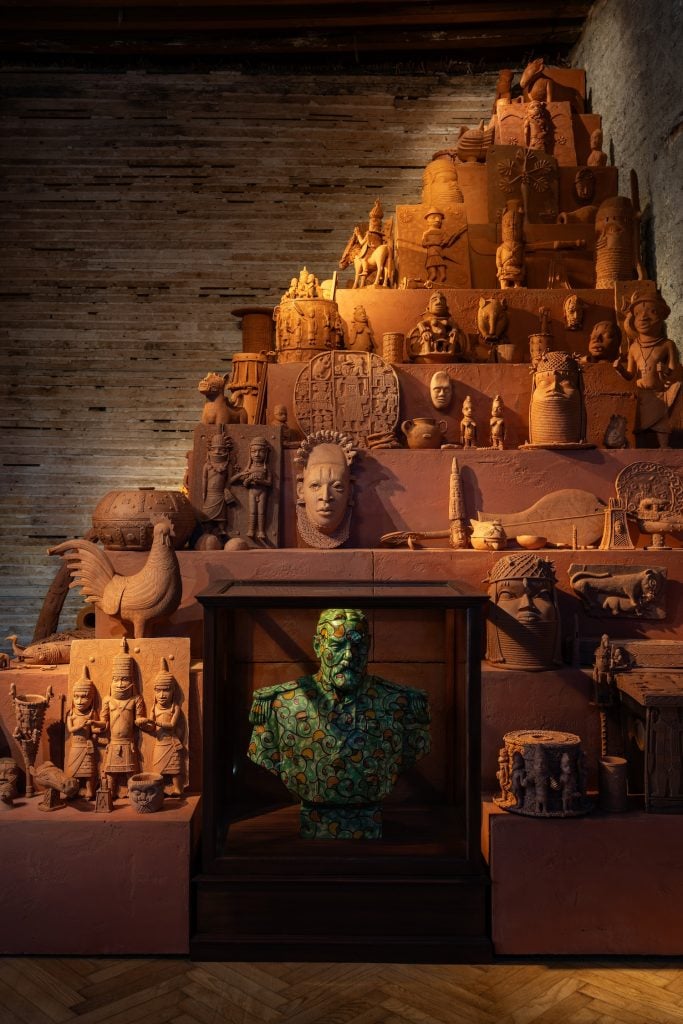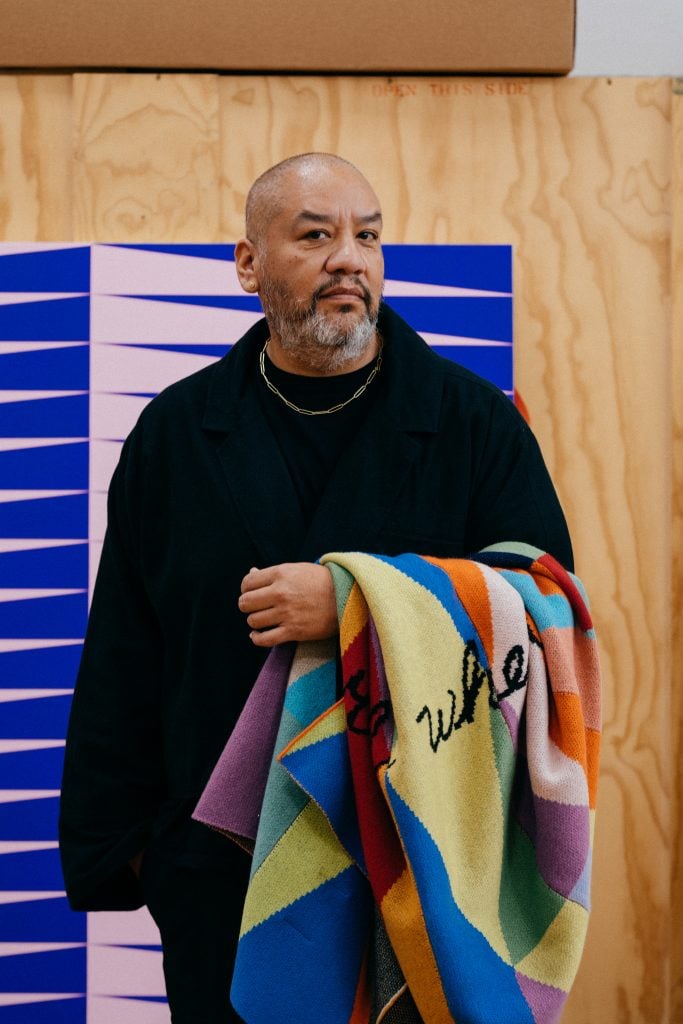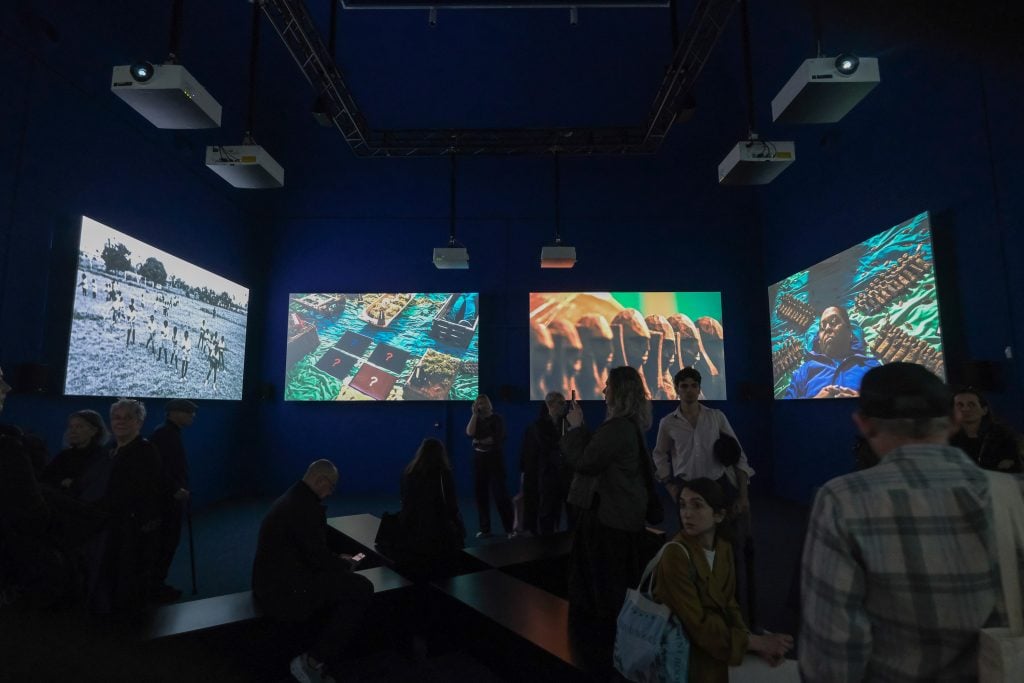Market
As Biennale Budgets Shrink, Auction Houses Help Fill the Gap
Christie's is supporting the British and Nigeria pavilions, while Sotheby's helped fund the U.S. pavilion.

Christie's is supporting the British and Nigeria pavilions, while Sotheby's helped fund the U.S. pavilion.

Margaret Carrigan

The art world sometimes pays lip service to a church-and-state divide between commercial business and institutional shows, but that boundary has long been porous. Gallery funding of artists’ projects at the Venice Biennale and other major international events has become commonplace, particularly as the budgets for such installations soar, and auction houses and other sales platforms are becoming increasingly visible in their support, especially at this year’s biennial.
Among the auction houses, Christie’s has led the way. It is supporting the British Pavilion, commissioned by the British Council, where the Ghana-born British artist John Akomfrah’s expansive film and sound installation, “Listening All Night to the Rain,” is on view. This is the second time the auction house has sponsored the pavilion; in 2022, it supported Sonia Boyce’s exhibition, which was awarded the Golden Lion for best national participation.
This year, Christie’s has also contributed funding for Nigeria’s pavilion, titled “Nigeria Imaginary,” which features a group show that includes works by Ndidi Dike and Yinka Shonibare, curated by Aindrea Emelife, an art historian and curator of modern and contemporary art at the Museum of West African Art (MOWAA), opening later this year in Benin City, Nigeria. The auction house previously worked with Emelife on “Bold, Black, and British,” a 2021 selling exhibition to raise money for the museum.
“As an auction house, we’re part of a wider ecosystem,” said Katharine Arnold, Christie’s head of postwar and contemporary art, Europe. “It’s a give and take: We benefit from artists’ creativity, so auction houses giving back is right and proper.” Arnold added that the support of Venice projects has nothing to do with whether or not the artist’s work could perform well on a commercial level. Indeed, Akomfrah, an acclaimed filmmaker, does not create the most market-friendly pieces, and his work has never appeared at a major auction house.

Yinka Shonibare CBE RA, Monument to the Restitution of the Mind and Soul (2023). Installation view, Nigeria Imaginary at the Nigeria Pavilion at the 60th International Art Exhibition — La Biennale di Venezia. Photo: Marco Cappelleti Studio. Courtesy of Museum of West African Art (MOWAA).
With so many deep-pocketed collectors visiting the biennale, auction houses have long operated in the background, organizing events like curator-led tours, talks, and invite-only dinners and cocktail receptions. “The Venice Biennale is a wonderful opportunity to connect with current clients and to be introduced to potential clients,” said Cheyenne Westphal, Phillips’s global chairwoman. While Phillips isn’t sponsoring any pavilions or other events this year, its specialists—like those of other auction houses—will be on the ground in Venice to scout the event.
The Biennial-Basel effect—wherein works by an artist included in the biennial in April are for sale (likely at a higher price than before) at Art Basel in June—is well known. But auction prices also jump for many biennial-featured artists. Westphal noted that the 2022 Venice Biennale highlighted the remarkable talent of artist Simone Leigh, “catalyzing a surge of commercial interest in her work—following the Venice Biennale, her art commanded exceptional attention from collectors, culminating in record-breaking prices at auction.” The artist’s auction record currently stands at $3.1 million, set for Las Meninas II (2019) at Sotheby’s last May.
This year’s biennale, “Foreigners Everywhere,” curated by Adriano Pedrosa, has a record number of artists—331, to be exact. But many of them are from groups that have long been marginalized or underrepresented in both the Western market and institutional spheres. That includes a number of Indigenous artists, like Jeffrey Gibson, who, after a rising tide of museum and gallery support over the last several years, is the first native artist to represent the United States solo since the country started participating in the event in 1930.

Jeffrey Gibson and Sotheby’s Limited Edition Blanket. Photo: Menelik Puryear.
To support Gibson’s $5.8 million vision for the U.S. pavilion, Sotheby’s launched the sale of specially-made patterned and embroidered blankets designed by the artist. The 60 limited-edition works are priced at $7,500 each, and proceeds from their sale will offset the costs of the show’s catalog and other educational and public programming resources for the pavilion.
“We are thrilled to support the United States Pavilion for the 60th Biennale Arte and Jeffrey Gibson with this exclusive collaboration, which we know our clients will love,” said Brooke Lampley, Sotheby’s chair and global head of fine art sales. “Jeffrey’s visionary approach to art promises to ignite profound conversations and inspire audiences globally and this partnership reinforces our commitment to supporting the leading artists of our time on this momentous occasion.”
Around three-quarters of the editions have sold so far, according to Sotheby’s, netting around $350,000. Still, that’s only a drop in the bucket of the multimillion-dollar budget for the pavilion. Additionally, the Ford Foundation gave $1.1 million, and the Mellon Foundation gave $1 million. The U.S. government’s support for the national pavilion only amounted to $375,000, according to the New York Times.
That modest sum gets at a major issue fueling investments in Venice projects by auction houses and other art businesses: state funding for the arts, even in many wealthy countries, is increasingly tight and completely out of step with the rising costs of production and labor.

Visitors look at installations inside the British pavilion at the Giardini during the 60th Biennale Art 2024 on April 16, 2024 in Venice, Italy. Photo: Stefano Mazzola/Getty Images.
“Venice can be deeply unfair,” said the art and development advisor, Leslie Ramos, author of Philanthropy in the Arts: A Game and Give and Take (2023) “ It is still considered the best thing to happen to an artist, like the Oscars, and if powerful galleries can support them through it, great. But for many artists, it has also become a fundraising campaign to realize projects, creating even more work rather than it being a cause for celebration.”
Artists “can’t create work out of thin air,” said Arnold, the Christie’s staffer, noting that the “shadow of the pandemic has loomed large” over artists and U.K. non-profit institutions alike, many of which are still recovering from financial losses against a backdrop of increasingly parsimonious art councils. It may come as no surprise, then, that the British Council-funded U.K. pavilion is also supported by the luxury brand Burberry, as well as Frieze, which contributed a five-figure sum to the production of Akomfrah’s work—the first time that an art fair has provided financial support for a national pavilion.
As the need for additional funding for Venice projects rises, market players clearly have a desire to be seen supporting the broader art landscape. Yet, with these increased commercial ties comes concerns that artists will be able to take fewer risks, instead creating works that serve brand relationships and investor needs. As production costs continue to climb and artists seek funds, it begs the question: who is this event for?